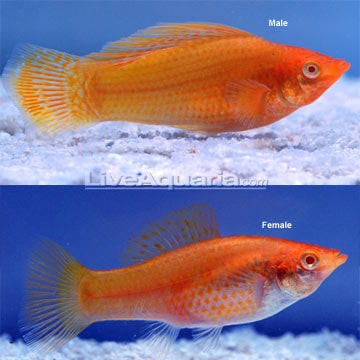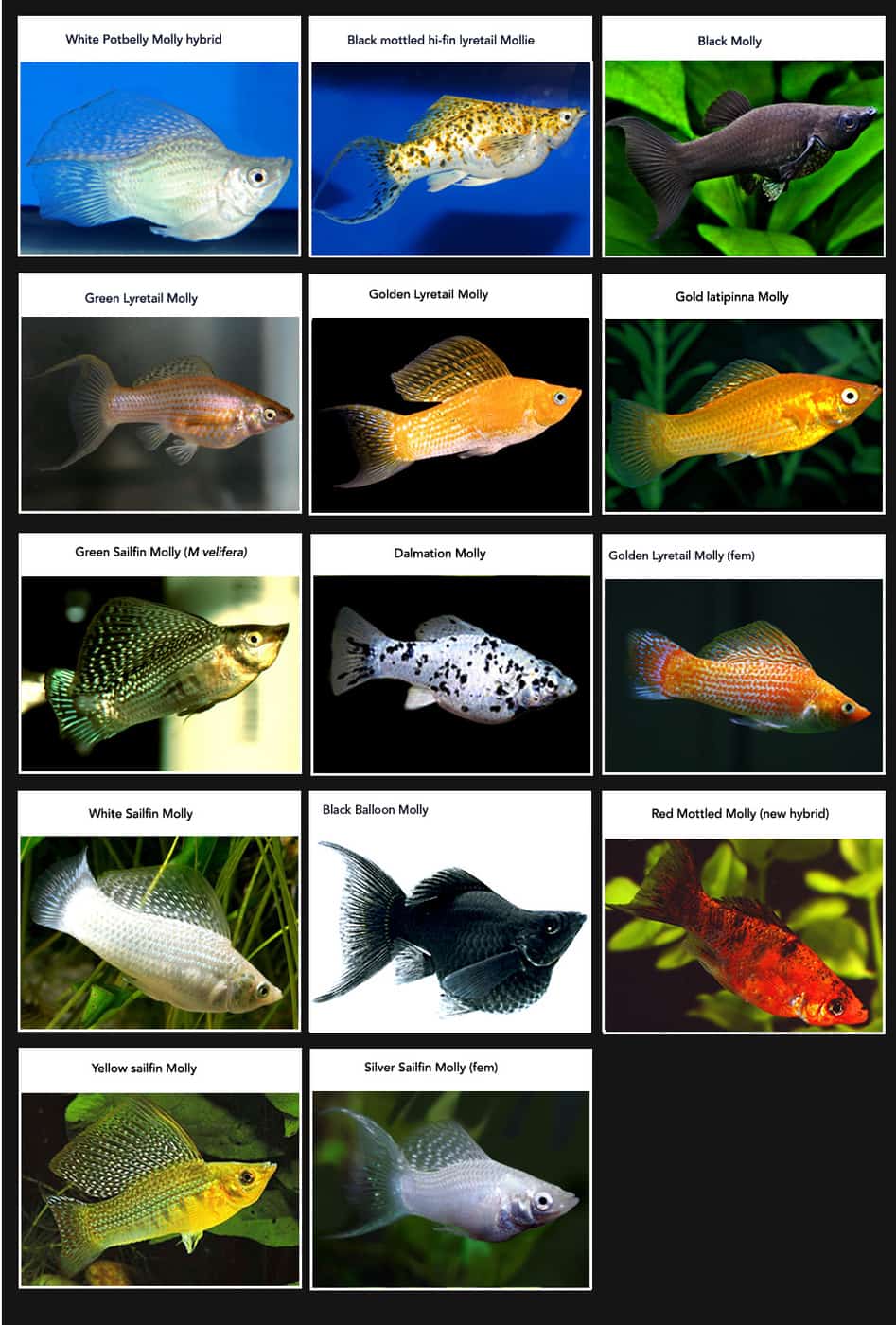Mollies are common freshwater aquarium fish. They look a lot like a cross between a tetra and a fancy goldfish. Mollies are good beginner fish, but can quickly overwhelm a system with their proliferative breeding habits.
Mollie Varieties
There are two main varieties of mollies, short-fin and sailfin or lyretail. Sailfin mollies are much larger with longer fins than their short-fin counterparts. They give birth to live young, and even the most novice of fish keepers will probably produce offspring. Very frequently, owners will adopt a pregnant female molly from the store. This will result in just one fish suddenly surrounded by a sea of offspring! If the young are not removed immediately, they may become snacks. To avoid breeding, you should keep only males or only females.  Males and females can be differentiated by the shape of their anal fin. Males have a anal fin that points backwards. Females’ anal fin looks just like the rest of their other fins.
Males and females can be differentiated by the shape of their anal fin. Males have a anal fin that points backwards. Females’ anal fin looks just like the rest of their other fins.
Mollies can be found in a variety of colors. Frequently, these colors, fin-shapes and patterns arise from vigorous cross-breeding along the same genetic line. Although this can product lots of unique colors, it can cause severe inbreeding issues. Inbreeding is common in live bearing fish species since they produce young so quickly.
Keeping Mollies
Overall, most mollies are peaceful, freshwater community fish. They can be kept with others of their own species, or with other community-minded species. More than one molly can be kept in a tank together, however, they have been known to nip the fins of others in their tank. It is recommended that only one male molly be kept in a tank since males will fight with each other to establish a dominant alpha fish. With this type of fish, you should stick to the 1 gallon of water per 1″ of fish. Since mollies usually grow up to 2″, a 10 gal tank should have no more than 4-5 fish. When thinking about how many fish you want in your tank, it is always better to err on the side of too few.
Due to their proliferative nature, you may need to clean your tank a little bit more frequently than your standard community tank. Live births can add an influx of protein, leading to higher ammonia and subsequent nitrite and nitrate levels.
You will require a heater for your molly tank. These fish like it just at subtropical levels, usually in the high 70s (24 to 26C). Some indoor systems will be able to maintain this temperature, but it is always better to have a heater backup to ensure your fish don’t get too cold (below 68F/20C).
Feeding Your Mollies
Mollies can be fed a combination of small tropical pellets with other occasional supplements, such as brine shrimp or blood worms. If you are interested in specifically breeding your mollies, you will need to increase their dietary protein in order to build robust offspring.
Common Molly Diseases
When it comes to mollies, there are a few diseases that these fish will carry more frequently. Keep in mind, with the potential inbreeding issue, any fish that has a tunneled genetic background can have immunological issues as well. You may notice fish with missing operculums (gill plate cover) or bent spines, which are clear indicators for inbreeding.
Parasites
Whenever fish pass through a pet store, they can come across pathogens from countless fish and water sources. Parasites, in particular, are very commonly spread between various fish populations because it doesn’t matter what species they are!
Bacteria
Let’s face it, fish live in a toilet. There is a constant influx of bacteria trying to get into your fish, but a healthy immune system will keep everything in check. Again, if your fish have inbreeding issues, they will be more susceptible to normal environmental bacteria and can get sicker faster.
Preventing Disease in Your Mollies
The best thing to do, regardless of what fish you are bringing home, is to quarantine your fish YOURSELF. Do not rely on the vendor or pet store to do it for you. Quarantining your new mollies for 4-6 weeks is the best thing you can do to prevent illness from spreading.
For more great information about caring for mollies, check out MollyFish.com and Aquatic Community


Dr.Jessie please could you tell me if I feed molly fish frozen dry tubifex worms will they get affected either swim bladder disease.Ir if I soak the tubifex worms before feeding will it lose its nutritional value.Or if I feed optimum fish food micro pellets is it an underrated pellet food it has (29%) protein content.Thank you
For specific husbandry and dietary questions, we recommend a virtual consultation. Sign up here: https://866fishvet.spp.io/order/onlineconsult
Pingback: Molly Fish Fry: The Early Days – FourWayMemphis
I would like to know if the water temperature affects the gender of the fry. I rescued several of my baby mollies, about 10, and when they grew up enough I realized they are all female. It surprised me. I just rescued several mollies from another fry. Still too small to see if they are male or female, but I would like to have a better ratio than before and I have read in several forums that “colder” water temperatures tend to aid in the production of more females. That chromosomes don’t determine gender in fish. Is this true?
There have been many studies that looked into this change: https://journals.plos.org/plosone/article?id=10.1371/journal.pone.0002837. Although not all species have been studied, some show a preference for females at lower temperatures than males, including some species of guppies.
Pingback: Feeding Baby Black Mollies – TheEcoBaby